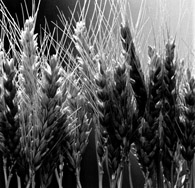
Federation wheat
1903
wheat variety resistant to fungus and drought
James Farrer was a highly educated and quite well-off doctor who came to Australia in the 1880s to recover from illness. As a surveyor in the new wheatlands of NSW, he became familiar with the devastating effects of rust fungus (which looks like rust) on wheat crops.
In 1886 he bought a farm at Lambrigg in NSW, intending to develop disease-free, high-yielding wheat. He established a name for himself as a researcher: he published the results of his wheat-breeding trials, wrote to other scientists, offered advice and attended conferences.
Frederick Guthrie, a chemist employed by the NSW government from 1892, developed methods to test small samples of grain. He measured the amount of wheat the samples yielded and determined their milling and baking quality. His results helped Farrer select the best new varieties from many small experimental crops.
In 1898 Farrer was put in charge of government research into wheat and developed drought resistant, early maturing varieties. He gave them names such as Bobs, Purple Straw and Federation. Because they matured early in the season, they could be harvested before the weather became too humid (humid conditions allowed rust fungus to grow). Federation wheat was the most popular variety in Australia until 1925.
There was a downside to this success. Farrer's drought resistant varieties allowed the extension of farming into areas of unreliable rainfall known as 'marginal wheatlands'. This caused dreadful hardship and environmental devastation when crops failed and the bare topsoil blew away.
Who Did It?
Key Organisations
Department of Agriculture, NSW : research, seed production
Key People
William Farrer : wheat breeder
Frederick Guthrie : agricultural chemist
Further Reading
Australian Dictionary of Biography
Melbourne University Press, 1983
Colin Wrigley, entries on Farrer (vol 8 pp 471-473) and Guthrie (vol 9 pp 143-144)
Links
Wheat in
Australia
Farrer
Farrer
and Guthrie
Plant breeding
the molecular way
|












